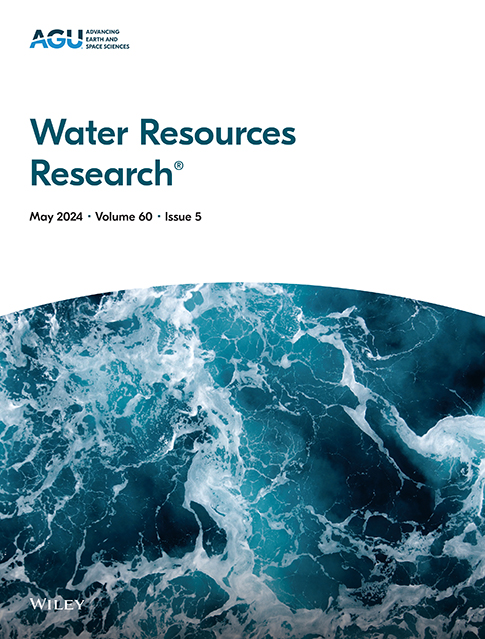Pore-Scale Study of Non-Clogging Accumulation Effects on Microgel Particle Transport and Multiphase Displacements in Porous Media
IF 5
1区 地球科学
Q2 ENVIRONMENTAL SCIENCES
引用次数: 0
Abstract
Particle transport in subsurface porous media under multiphase flow conditions is widely concerned in many practical applications. Previous studies have focused on retention behaviors and interfacial effects, ignoring the unique role of pronounced rheological effect under dilute conditions. Here, we investigate how accumulation effect reshapes microgel particle transport and immiscible displacement process driven by concentration-sensitive viscosity. As a foundation, a mixture-rheology two-fluid model is developed and combined with color-gradient lattice Boltzmann method for modeling complex particulate multiphase flow. The consistency between simulation results and microfluidic experiments confirms the validity of our model in capturing accumulation phenomena. Results in heterogeneous dual-permeability structures reveal the two-way coupling between particle accumulation and interfacial evolution. Particle accumulation can be enhanced at higher injection concentrations and larger particle sizes, leading to the formation of filter-cake-like structures despite the absence of clogging effects. Capillary resistance further weakens the driving force for particle migration, intensifying local accumulation compared to suspension flow. The non-uniform concentration distribution contributes to flow rate reallocation via diversion effects, producing variable displacement patterns under varying conditions. Results in disordered media exhibit a similar trend as in the dual-permeability model but with more significant accumulation. The dramatic reduction in nonaqueous phase saturation by sweeping efficiency improvement indicates the promising application potential of such accumulation. Our findings deepen the understandings of particle transport in porous media with implications for manipulation of immiscible displacement.多孔介质中非堵塞堆积对微凝胶颗粒输运和多相位移影响的孔隙尺度研究
多相流条件下的颗粒在地下多孔介质中的输运在许多实际应用中受到广泛关注。以往的研究主要集中在保留行为和界面效应上,忽视了稀释条件下明显的流变效应的独特作用。在这里,我们研究积聚效应如何重塑微凝胶颗粒运输和由浓度敏感粘度驱动的不混相置换过程。在此基础上,建立了混合-流变两流体模型,并结合颜色梯度晶格玻尔兹曼方法对复杂颗粒多相流进行建模。仿真结果与微流控实验结果的一致性证实了该模型在捕获堆积现象方面的有效性。非均质双渗透结构揭示了颗粒积聚与界面演化之间的双向耦合。较高的注入浓度和较大的颗粒尺寸可以增强颗粒的积聚,导致滤饼状结构的形成,尽管没有堵塞效应。与悬浮流动相比,毛细阻力进一步削弱了颗粒迁移的驱动力,加剧了局部堆积。不均匀的浓度分布有助于通过导流效应重新分配流量,在不同条件下产生不同的驱替模式。无序介质的结果表现出与双渗透模型相似的趋势,但积聚更明显。提高扫矿效率显著降低了非水相饱和度,表明了这种储层具有良好的应用潜力。我们的发现加深了对多孔介质中颗粒输运的理解,并对非混相位移的操纵产生了影响。
本文章由计算机程序翻译,如有差异,请以英文原文为准。
求助全文
约1分钟内获得全文
求助全文
来源期刊

Water Resources Research
环境科学-湖沼学
CiteScore
8.80
自引率
13.00%
发文量
599
审稿时长
3.5 months
期刊介绍:
Water Resources Research (WRR) is an interdisciplinary journal that focuses on hydrology and water resources. It publishes original research in the natural and social sciences of water. It emphasizes the role of water in the Earth system, including physical, chemical, biological, and ecological processes in water resources research and management, including social, policy, and public health implications. It encompasses observational, experimental, theoretical, analytical, numerical, and data-driven approaches that advance the science of water and its management. Submissions are evaluated for their novelty, accuracy, significance, and broader implications of the findings.
 求助内容:
求助内容: 应助结果提醒方式:
应助结果提醒方式:


